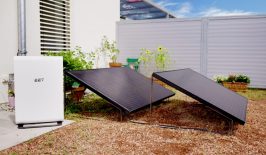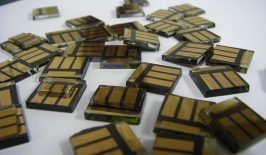In a bid to solve this problem, a study at the North Carolina State University has investigated the possibility of incorporating solar cells directly into greenhouses in order to offset some of their power requirements. Traditional opaque solar panels would be useless at this, of course, as they would also block the light getting to the plants below – but a new generation of semi-transparent solar cells would provide a solution.
The team developed a computational model which could accurately assess the power generation potential of solar cells on tomato-producing greenhouses in three US states: Arizona, North Carolina and Wisconsin. They chose glass-like organic solar cells due to their light weight, low cost and semi-transparent construction. Solar panels like these could essentially replace the glass roof of a greenhouse, providing a large surface area for energy production.
Creating a Balance Between Power and Growth
The team looked in particular into creating solar cells that would block only certain wavelengths of the light spectrum. Plants only use specific wavelengths for photosynthesis, so they hoped to maximise plant growth by prioritising the capture of those wave lengths that aren’t used by the plants.
Because, unfortunately, solar panels would always end up blocking at least some of the light needed by the plants, the computational model hoped to find a trade off, a perfect balance, between power generation and plant growth. The team discovered that in some locations, the trade off would be so small that using these kind of semi-transparent solar cells could even result in essentially energy-neutral greenhouses.
In Arizona, greenhouses could become zero-energy by blocking only ten percent of the photosynthetic band of light. In North Carolina, the same effect could be achieved by blocking around twenty percent. In some cases, growers might be able to generate up to twice as much energy as they needed with only minor additional sacrifices to growing potential.
However, the study found that greenhouses in colder, and less sunny, Wisconsin – which have higher energy demands – would be unable to become energy-neutral in the same manner with the semi-transparent solar cells. Growers there would still be able to offset almost half of their power use, however – reducing costs and increasing sustainability.
This solar panel solution would invariably mean that growers would lose some output in terms of produce, bu it’s hoped that the energy savings would be enough to convince at least some greenhouse operators of the new solar panels’ potential. Brendan O’Connor, co-author of the study and an associate professor of mechanical and aerospace engineering at North Carolina State University explained:
“While the technology does use some of the light plants rely on, we think the impact will be negligible on plant growth – and that the trade-off will make financial sense to growers.”
The development of “building-integrated photovoltaics” – where solar panels are installed directly into buildings, and not just on the roof – drastically increases the surface area that buildings have available for solar power generation. And it’s a growing field. Lots of research is currently being done to develop different types of solar energy producing windows and into glass building blocks that can be built directly into walls. Innovators have even developed the idea of creating roads embedded with solar panels. The energy generated could used to charge electric cars, remove ice patches from the road surface and even power safety lights at night.






